Home / The Malonic Ester and Acetoacetic Ester Synthesis
Enols and Enolates
The Malonic Ester and Acetoacetic Ester Synthesis
Last updated: February 1st, 2023 |
The Malonic Ester Synthesis And Its Cousin, The Acetoacetic Ester Synthesis
- In the malonic ester synthesis, a di-ester of malonic acid is deprotonated with a weak base, and then undergoes C–C bond formation at the alpha position with an alkyl halide (enolate alkylation)
- Treatment with aqueous acid results in hydrolysis of the ester. Upon heating, decarboxylation spontaneously occurs to give a chain-extended carboxylic acid.
- A related process, the acetoacetic ester synthesis, results in alkylated ketones.
- The reaction has the advantage that only an alkoxide base is required and there are none of the problems with regioselectivity that sometimes occur in the alkylation of substituted ketones with alkoxides.
- If desired, two alkylations can be carried out before the decarboxylation step.
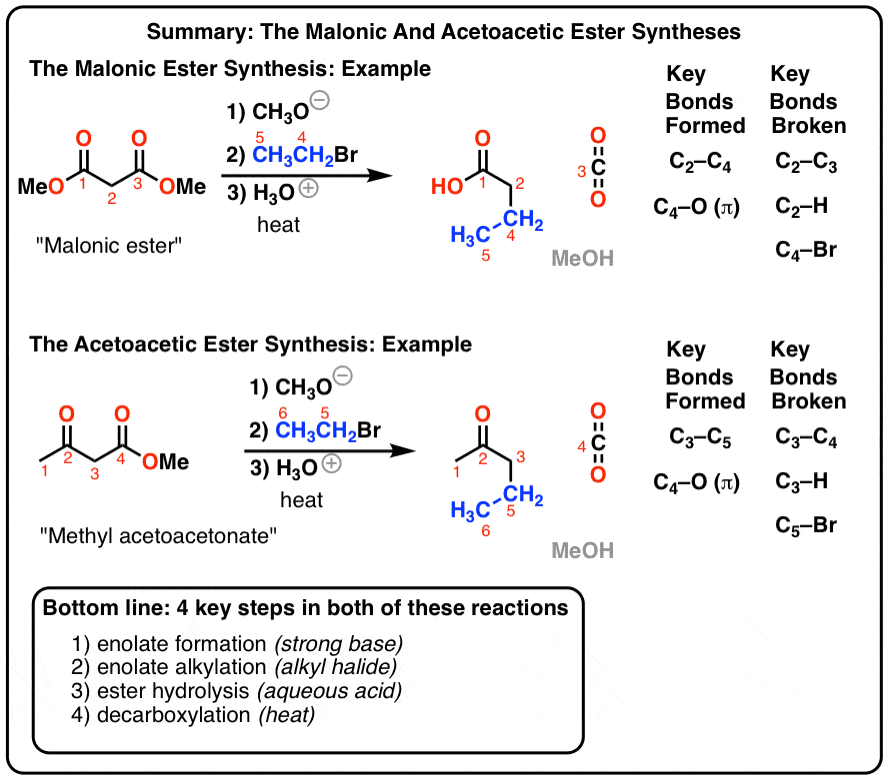
Table of Contents
- The Common Pattern In The Malonic Ester Synthesis
- The Malonic Ester Synthesis Is Comprised Of Five Separate Reactions
- Step 1: Deprotonation To Give An Enolate
- Step 2: SN2 Reaction Of The Enolate Nucleophile With An Alkyl Halide Electrophile
- Step 3: Acidic Ester Hydrolysis
- Step 4: Decarboxylation To Give An Enol
- Step 5: Tautomerization Of The Enol Back To The Carboxylic Acid
- (Advanced) References and Further Reading
1. The Common Pattern In The Malonic Ester Synthesis
Before going into the mechanism, see if you can identify the common pattern for each of these malonic ester syntheses. Follow the different colors of atoms. Where does each come from? Where do each of them go?
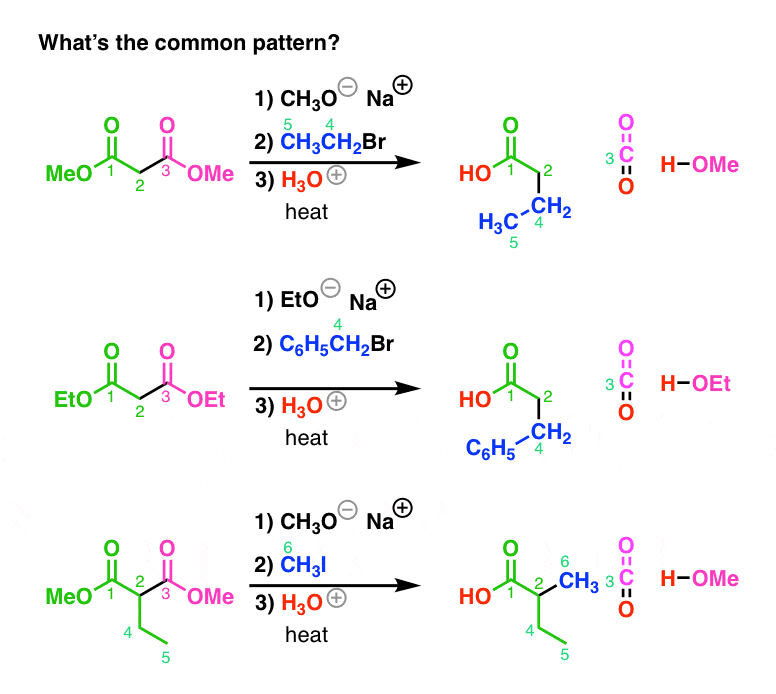
The cool thing about this process is how it’s built from a series of simple reactions. Again, mechanisms in organic chemistry are a lot like music – from a small number of parts, we can build up something complex.
Let’s walk through the mechanism (focusing on the malonic ester synthesis for brevity – the acetoacetic ester synthesis mechanism is identical except we’re starting with a different compound).
The Malonic Ester Synthesis Is Comprised Of Five Separate Reactions
These processes are built out of five reactions in total:
- deprotonation of the ester to form an enolate
- SN2 of the enolate upon an alkyl halide, forming a new C-C bond
- acidic hydrolysis of the ester to give a carboxylic acid
- decarboxylation of the carboxylic acid to give an enol
- tautomerization of the resulting enol to a carboxylic acid
Step 1: Deprotonation To Give An Enolate
In the first step, a base (CH3O– in this case) removes the most acidic proton from the ester (on C2 here, with a pKa of about 13) to give an enolate. The resulting enolate can be drawn as one of two resonance forms.
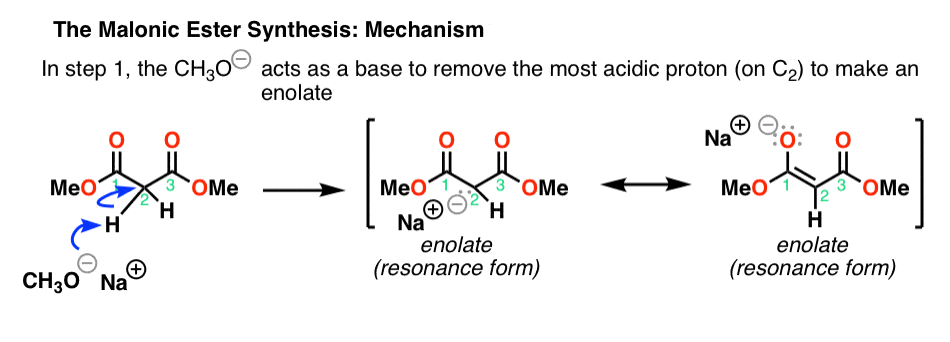
Step 2: SN2 Reaction Of The Enolate Nucleophile With An Alkyl Halide Electrophile
Enolates are great nucleophiles. In the second step, the enolate acts as a nucleophile in an SN2 reaction to form a new C-C bond:

Step 3: Acidic Ester Hydrolysis
Next (step 3), acid and water are added to perform the aqueous hydrolysis of the ester to a carboxylic acid.

Step 4: Decarboxylation To Give An Enol
Now comes the part which often gives students trouble. When carboxylic acids have a carbonyl group (C=O) two bonds away, they can readily lose carbon dioxide. Why? Because the carbonyl can act as an electron “sink” for the pair of electrons coming from the breaking C–C bond, forming an enol. This is called “decarboxylation”. Note how this is also the case for carboxylic acids with a ketone two bonds away, so-called “β-keto acids”. [See article – Decarboxylation]

Step 5: Tautomerization Of The Enol Back To The Carboxylic Acid
Finally, the enol that is formed is not a stable species. It can undergo transformation into its constitutional isomer: in this case, a carboxylic acid. These two constitutional isomers are in equilibrium with each other, although the “keto” form (with the carbonyl group) is greatly favored. This process is called “tautomerism“. [See article: Keto-enol tautomerism]
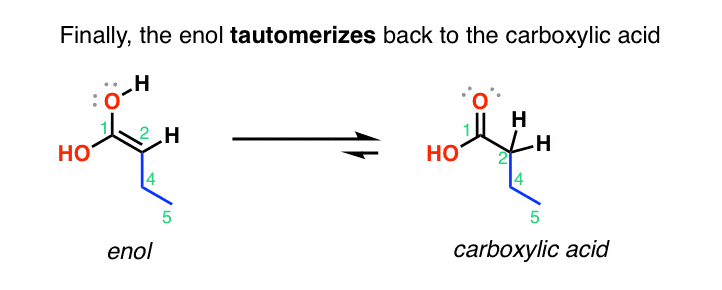
Again, the key point to make about the malonic ester synthesis is to observe the pattern of bonds formed and bonds broken. As with any reaction in organic chemistry, if you can see the pattern going forward, you should be able to apply it going backward as well. See if you can figure out how to make compound A from a malonic ester synthesis.
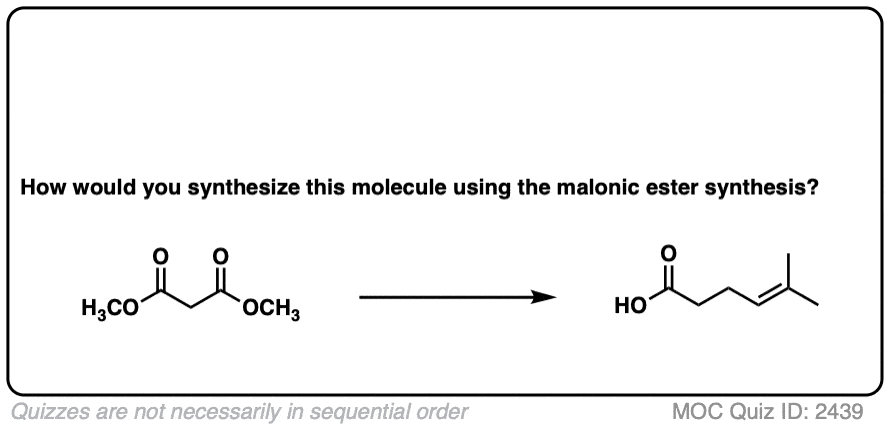 Click to Flip
Click to Flip
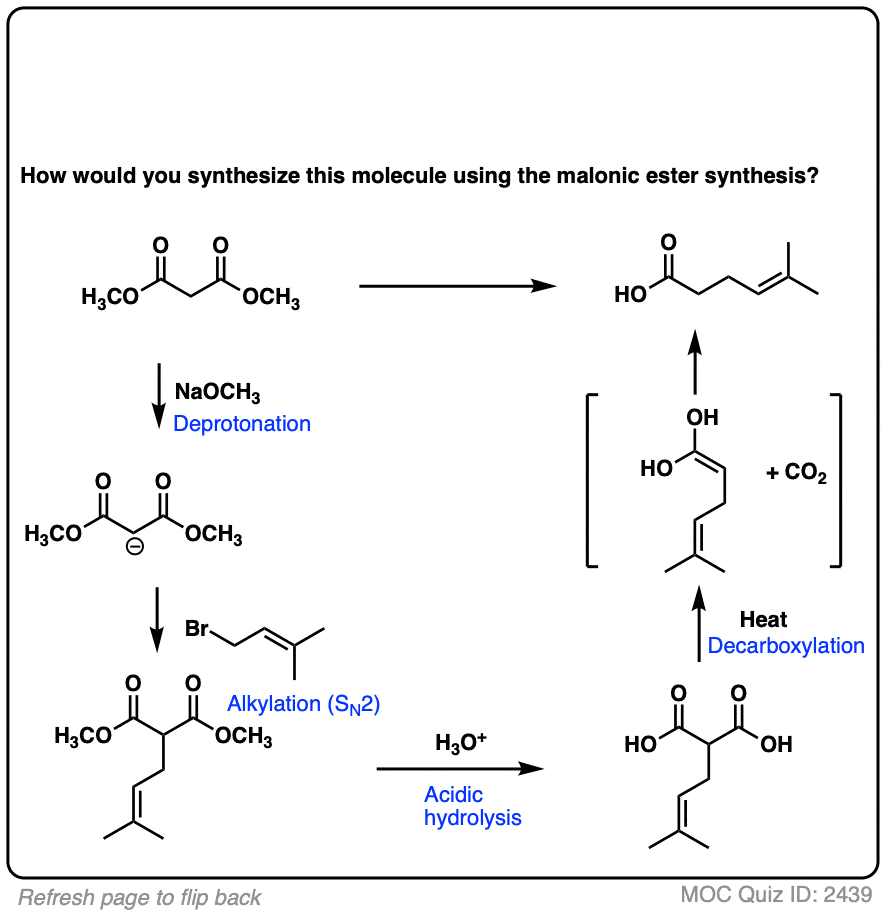
Secondly, it’s also possible to do two alkylations before doing the aqueous hydrolysis step. Can you figure out how to make B from a malonic ester synthesis?
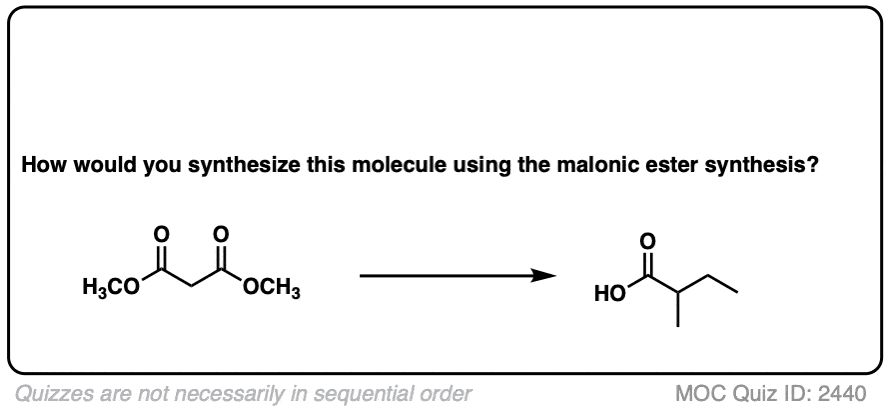 Click to Flip
Click to Flip
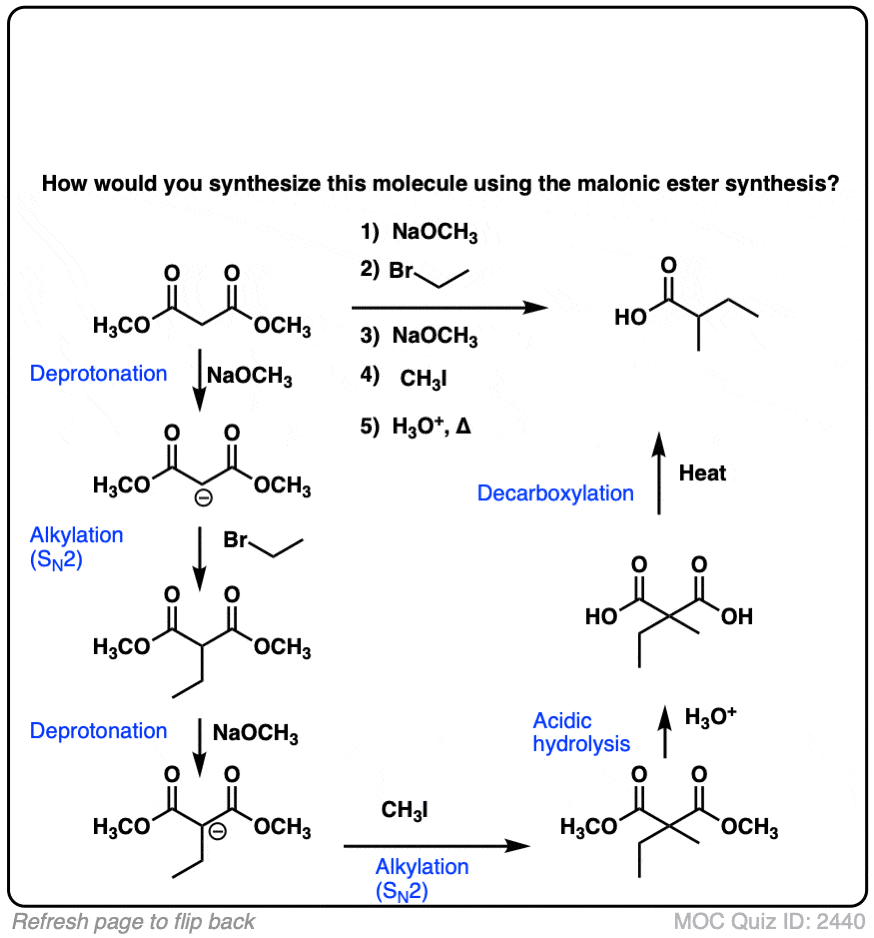
Notes
Related Articles
- Decarboxylation
- Keto-Enol Tautomerism
- Reactions of Enols – Acid-Catalyzed Aldol, Halogenation, and Mannich Reactions
- Enolates – Formation, Stability, and Simple Reactions
- The Malonic Ester Synthesis (MOC Membership)
- Making Music With Mechanisms (PADPED)
- Decarboxylation of beta-keto carboxylic acids (MOC Membership)
- Hydrolysis of esters to carboxylic acids with aqueous acid (MOC Membership)
(Advanced) References and Further Reading
- THE ADDITION OF MALONIC ESTERS TO BENZOYL-PHENYL-ACETYLENE.
Elmer P. Kohler
Journal of the American Chemical Society 1922, 44 (2), 379-385
DOI: 10.1021/ja01423a019
One of the earliest instances in the literature of the use of malonic esters in organic synthesis. - THE CLEAVAGE OF DISUBSTITUTED MALONIC ESTERS BY SODIUM ETHOXIDE
Arthur C. Cope and S. M. McElvain
Journal of the American Chemical Society 1932, 54 (11), 4319-4325
DOI: 1021/ja01350a026
This paper by Prof. A. C. Cope (of the Cope Rearrangement) shows that malonic acid esters can be synthesized from aliphatic acid enolates with diethyl carbonate. - The Alkylation of Malonic Ester
Ralph G. Pearson
Journal of the American Chemical Society 1949, 71 (6), 2212-2214
DOI:1021/ja01174a080
This paper is a very rigorous physical-organic study of the malonic ester synthesis and shows that the rate of alkylation is related to the acidity of the a-proton in the malonic ester. - The malonic ester synthesis in the undergraduate laboratory
Bernard E. Hoogenboom, Phillip J. Ihrig, Arne N. Langsjoen, Carol J. Linn, and Stephen D. Mulder
Journal of Chemical Education 1991, 68 (8), 689
DOI: 1021/ed068p689
This publication describes a prototypical but still simplified method for carrying out the malonic ester synthesis, making it amenable for undergraduate organic chemistry laboratory courses. - DIETHYL 1,1-CYCLOBUTANEDICARBOXYLATE
Raymond P. Mariella and Richard Raube
Org Synth. 1953, 33, 23
DOI: 10.15227/orgsyn.033.0023
This procedure uses a dihalide to effect an intramolecular cyclization, which is also known as the Perkin alicyclic synthesis. Organic Syntheses, which is published by the ACS’s Organic Chemistry division, is a reputable source of reliable and independently tested synthetic organic laboratory procedures.
00 General Chemistry Review
01 Bonding, Structure, and Resonance
- How Do We Know Methane (CH4) Is Tetrahedral?
- Hybrid Orbitals and Hybridization
- How To Determine Hybridization: A Shortcut
- Orbital Hybridization And Bond Strengths
- Sigma bonds come in six varieties: Pi bonds come in one
- A Key Skill: How to Calculate Formal Charge
- The Four Intermolecular Forces and How They Affect Boiling Points
- 3 Trends That Affect Boiling Points
- How To Use Electronegativity To Determine Electron Density (and why NOT to trust formal charge)
- Introduction to Resonance
- How To Use Curved Arrows To Interchange Resonance Forms
- Evaluating Resonance Forms (1) - The Rule of Least Charges
- How To Find The Best Resonance Structure By Applying Electronegativity
- Evaluating Resonance Structures With Negative Charges
- Evaluating Resonance Structures With Positive Charge
- Exploring Resonance: Pi-Donation
- Exploring Resonance: Pi-acceptors
- In Summary: Evaluating Resonance Structures
- Drawing Resonance Structures: 3 Common Mistakes To Avoid
- How to apply electronegativity and resonance to understand reactivity
- Bond Hybridization Practice
- Structure and Bonding Practice Quizzes
- Resonance Structures Practice
02 Acid Base Reactions
- Introduction to Acid-Base Reactions
- Acid Base Reactions In Organic Chemistry
- The Stronger The Acid, The Weaker The Conjugate Base
- Walkthrough of Acid-Base Reactions (3) - Acidity Trends
- Five Key Factors That Influence Acidity
- Acid-Base Reactions: Introducing Ka and pKa
- How to Use a pKa Table
- The pKa Table Is Your Friend
- A Handy Rule of Thumb for Acid-Base Reactions
- Acid Base Reactions Are Fast
- pKa Values Span 60 Orders Of Magnitude
- How Protonation and Deprotonation Affect Reactivity
- Acid Base Practice Problems
03 Alkanes and Nomenclature
- Meet the (Most Important) Functional Groups
- Condensed Formulas: Deciphering What the Brackets Mean
- Hidden Hydrogens, Hidden Lone Pairs, Hidden Counterions
- Don't Be Futyl, Learn The Butyls
- Primary, Secondary, Tertiary, Quaternary In Organic Chemistry
- Branching, and Its Affect On Melting and Boiling Points
- The Many, Many Ways of Drawing Butane
- Wedge And Dash Convention For Tetrahedral Carbon
- Common Mistakes in Organic Chemistry: Pentavalent Carbon
- Table of Functional Group Priorities for Nomenclature
- Summary Sheet - Alkane Nomenclature
- Organic Chemistry IUPAC Nomenclature Demystified With A Simple Puzzle Piece Approach
- Boiling Point Quizzes
- Organic Chemistry Nomenclature Quizzes
04 Conformations and Cycloalkanes
- Staggered vs Eclipsed Conformations of Ethane
- Conformational Isomers of Propane
- Newman Projection of Butane (and Gauche Conformation)
- Introduction to Cycloalkanes
- Geometric Isomers In Small Rings: Cis And Trans Cycloalkanes
- Calculation of Ring Strain In Cycloalkanes
- Cycloalkanes - Ring Strain In Cyclopropane And Cyclobutane
- Cyclohexane Conformations
- Cyclohexane Chair Conformation: An Aerial Tour
- How To Draw The Cyclohexane Chair Conformation
- The Cyclohexane Chair Flip
- The Cyclohexane Chair Flip - Energy Diagram
- Substituted Cyclohexanes - Axial vs Equatorial
- Ranking The Bulkiness Of Substituents On Cyclohexanes: "A-Values"
- Cyclohexane Chair Conformation Stability: Which One Is Lower Energy?
- Fused Rings - Cis-Decalin and Trans-Decalin
- Naming Bicyclic Compounds - Fused, Bridged, and Spiro
- Bredt's Rule (And Summary of Cycloalkanes)
- Newman Projection Practice
- Cycloalkanes Practice Problems
05 A Primer On Organic Reactions
- The Most Important Question To Ask When Learning a New Reaction
- Curved Arrows (for reactions)
- Nucleophiles and Electrophiles
- The Three Classes of Nucleophiles
- Nucleophilicity vs. Basicity
- What Makes A Good Nucleophile?
- What Makes A Good Leaving Group?
- 3 Factors That Stabilize Carbocations
- Equilibrium and Energy Relationships
- 7 Factors that stabilize negative charge in organic chemistry
- 7 Factors That Stabilize Positive Charge in Organic Chemistry
- What's a Transition State?
- Hammond's Postulate
- Learning Organic Chemistry Reactions: A Checklist (PDF)
- Introduction to Oxidative Cleavage Reactions
06 Free Radical Reactions
- Bond Dissociation Energies = Homolytic Cleavage
- Free Radical Reactions
- 3 Factors That Stabilize Free Radicals
- What Factors Destabilize Free Radicals?
- Bond Strengths And Radical Stability
- Free Radical Initiation: Why Is "Light" Or "Heat" Required?
- Initiation, Propagation, Termination
- Monochlorination Products Of Propane, Pentane, And Other Alkanes
- Selectivity In Free Radical Reactions
- Selectivity in Free Radical Reactions: Bromination vs. Chlorination
- Halogenation At Tiffany's
- Allylic Bromination
- Bonus Topic: Allylic Rearrangements
- In Summary: Free Radicals
- Synthesis (2) - Reactions of Alkanes
- Free Radicals Practice Quizzes
07 Stereochemistry and Chirality
- Types of Isomers: Constitutional Isomers, Stereoisomers, Enantiomers, and Diastereomers
- How To Draw The Enantiomer Of A Chiral Molecule
- How To Draw A Bond Rotation
- Introduction to Assigning (R) and (S): The Cahn-Ingold-Prelog Rules
- Assigning Cahn-Ingold-Prelog (CIP) Priorities (2) - The Method of Dots
- Enantiomers vs Diastereomers vs The Same? Two Methods For Solving Problems
- Assigning R/S To Newman Projections (And Converting Newman To Line Diagrams)
- How To Determine R and S Configurations On A Fischer Projection
- The Meso Trap
- Optical Rotation, Optical Activity, and Specific Rotation
- Optical Purity and Enantiomeric Excess
- What's a Racemic Mixture?
- Chiral Allenes And Chiral Axes
- Stereochemistry Practice Problems and Quizzes
08 Substitution Reactions
- Nucleophilic Substitution Reactions - Introduction
- Two Types of Nucleophilic Substitution Reactions
- The SN2 Mechanism
- Why the SN2 Reaction Is Powerful
- The SN1 Mechanism
- The Conjugate Acid Is A Better Leaving Group
- Comparing the SN1 and SN2 Reactions
- Polar Protic? Polar Aprotic? Nonpolar? All About Solvents
- Steric Hindrance is Like a Fat Goalie
- Common Blind Spot: Intramolecular Reactions
- Substitution Practice - SN1
- Substitution Practice - SN2
09 Elimination Reactions
- Elimination Reactions (1): Introduction And The Key Pattern
- Elimination Reactions (2): The Zaitsev Rule
- Elimination Reactions Are Favored By Heat
- Two Elimination Reaction Patterns
- The E1 Reaction
- The E2 Mechanism
- E1 vs E2: Comparing the E1 and E2 Reactions
- Antiperiplanar Relationships: The E2 Reaction and Cyclohexane Rings
- Bulky Bases in Elimination Reactions
- Comparing the E1 vs SN1 Reactions
- Elimination (E1) Reactions With Rearrangements
- E1cB - Elimination (Unimolecular) Conjugate Base
- Elimination (E1) Practice Problems And Solutions
- Elimination (E2) Practice Problems and Solutions
10 Rearrangements
11 SN1/SN2/E1/E2 Decision
- Identifying Where Substitution and Elimination Reactions Happen
- Deciding SN1/SN2/E1/E2 (1) - The Substrate
- Deciding SN1/SN2/E1/E2 (2) - The Nucleophile/Base
- SN1 vs E1 and SN2 vs E2 : The Temperature
- Deciding SN1/SN2/E1/E2 - The Solvent
- Wrapup: The Key Factors For Determining SN1/SN2/E1/E2
- Alkyl Halide Reaction Map And Summary
- SN1 SN2 E1 E2 Practice Problems
12 Alkene Reactions
- E and Z Notation For Alkenes (+ Cis/Trans)
- Alkene Stability
- Alkene Addition Reactions: "Regioselectivity" and "Stereoselectivity" (Syn/Anti)
- Stereoselective and Stereospecific Reactions
- Hydrohalogenation of Alkenes and Markovnikov's Rule
- Hydration of Alkenes With Aqueous Acid
- Rearrangements in Alkene Addition Reactions
- Halogenation of Alkenes and Halohydrin Formation
- Oxymercuration Demercuration of Alkenes
- Hydroboration Oxidation of Alkenes
- m-CPBA (meta-chloroperoxybenzoic acid)
- OsO4 (Osmium Tetroxide) for Dihydroxylation of Alkenes
- Palladium on Carbon (Pd/C) for Catalytic Hydrogenation of Alkenes
- Cyclopropanation of Alkenes
- A Fourth Alkene Addition Pattern - Free Radical Addition
- Alkene Reactions: Ozonolysis
- Summary: Three Key Families Of Alkene Reaction Mechanisms
- Synthesis (4) - Alkene Reaction Map, Including Alkyl Halide Reactions
- Alkene Reactions Practice Problems
13 Alkyne Reactions
- Acetylides from Alkynes, And Substitution Reactions of Acetylides
- Partial Reduction of Alkynes With Lindlar's Catalyst
- Partial Reduction of Alkynes With Na/NH3 To Obtain Trans Alkenes
- Alkyne Hydroboration With "R2BH"
- Hydration and Oxymercuration of Alkynes
- Hydrohalogenation of Alkynes
- Alkyne Halogenation: Bromination, Chlorination, and Iodination of Alkynes
- Alkyne Reactions - The "Concerted" Pathway
- Alkenes To Alkynes Via Halogenation And Elimination Reactions
- Alkynes Are A Blank Canvas
- Synthesis (5) - Reactions of Alkynes
- Alkyne Reactions Practice Problems With Answers
14 Alcohols, Epoxides and Ethers
- Alcohols - Nomenclature and Properties
- Alcohols Can Act As Acids Or Bases (And Why It Matters)
- Alcohols - Acidity and Basicity
- The Williamson Ether Synthesis
- Ethers From Alkenes, Tertiary Alkyl Halides and Alkoxymercuration
- Alcohols To Ethers via Acid Catalysis
- Cleavage Of Ethers With Acid
- Epoxides - The Outlier Of The Ether Family
- Opening of Epoxides With Acid
- Epoxide Ring Opening With Base
- Making Alkyl Halides From Alcohols
- Tosylates And Mesylates
- PBr3 and SOCl2
- Elimination Reactions of Alcohols
- Elimination of Alcohols To Alkenes With POCl3
- Alcohol Oxidation: "Strong" and "Weak" Oxidants
- Demystifying The Mechanisms of Alcohol Oxidations
- Protecting Groups For Alcohols
- Thiols And Thioethers
- Calculating the oxidation state of a carbon
- Oxidation and Reduction in Organic Chemistry
- Oxidation Ladders
- SOCl2 Mechanism For Alcohols To Alkyl Halides: SN2 versus SNi
- Alcohol Reactions Roadmap (PDF)
- Alcohol Reaction Practice Problems
- Epoxide Reaction Quizzes
- Oxidation and Reduction Practice Quizzes
15 Organometallics
- What's An Organometallic?
- Formation of Grignard and Organolithium Reagents
- Organometallics Are Strong Bases
- Reactions of Grignard Reagents
- Protecting Groups In Grignard Reactions
- Synthesis Problems Involving Grignard Reagents
- Grignard Reactions And Synthesis (2)
- Organocuprates (Gilman Reagents): How They're Made
- Gilman Reagents (Organocuprates): What They're Used For
- The Heck, Suzuki, and Olefin Metathesis Reactions (And Why They Don't Belong In Most Introductory Organic Chemistry Courses)
- Reaction Map: Reactions of Organometallics
- Grignard Practice Problems
16 Spectroscopy
- Degrees of Unsaturation (or IHD, Index of Hydrogen Deficiency)
- Conjugation And Color (+ How Bleach Works)
- Introduction To UV-Vis Spectroscopy
- UV-Vis Spectroscopy: Absorbance of Carbonyls
- UV-Vis Spectroscopy: Practice Questions
- Bond Vibrations, Infrared Spectroscopy, and the "Ball and Spring" Model
- Infrared Spectroscopy: A Quick Primer On Interpreting Spectra
- IR Spectroscopy: 4 Practice Problems
- 1H NMR: How Many Signals?
- Homotopic, Enantiotopic, Diastereotopic
- Diastereotopic Protons in 1H NMR Spectroscopy: Examples
- 13-C NMR - How Many Signals
- Liquid Gold: Pheromones In Doe Urine
- Natural Product Isolation (1) - Extraction
- Natural Product Isolation (2) - Purification Techniques, An Overview
- Structure Determination Case Study: Deer Tarsal Gland Pheromone
17 Dienes and MO Theory
- What To Expect In Organic Chemistry 2
- Are these molecules conjugated?
- Conjugation And Resonance In Organic Chemistry
- Bonding And Antibonding Pi Orbitals
- Molecular Orbitals of The Allyl Cation, Allyl Radical, and Allyl Anion
- Pi Molecular Orbitals of Butadiene
- Reactions of Dienes: 1,2 and 1,4 Addition
- Thermodynamic and Kinetic Products
- More On 1,2 and 1,4 Additions To Dienes
- s-cis and s-trans
- The Diels-Alder Reaction
- Cyclic Dienes and Dienophiles in the Diels-Alder Reaction
- Stereochemistry of the Diels-Alder Reaction
- Exo vs Endo Products In The Diels Alder: How To Tell Them Apart
- HOMO and LUMO In the Diels Alder Reaction
- Why Are Endo vs Exo Products Favored in the Diels-Alder Reaction?
- Diels-Alder Reaction: Kinetic and Thermodynamic Control
- The Retro Diels-Alder Reaction
- The Intramolecular Diels Alder Reaction
- Regiochemistry In The Diels-Alder Reaction
- The Cope and Claisen Rearrangements
- Electrocyclic Reactions
- Electrocyclic Ring Opening And Closure (2) - Six (or Eight) Pi Electrons
- Diels Alder Practice Problems
- Molecular Orbital Theory Practice
18 Aromaticity
- Introduction To Aromaticity
- Rules For Aromaticity
- Huckel's Rule: What Does 4n+2 Mean?
- Aromatic, Non-Aromatic, or Antiaromatic? Some Practice Problems
- Antiaromatic Compounds and Antiaromaticity
- The Pi Molecular Orbitals of Benzene
- The Pi Molecular Orbitals of Cyclobutadiene
- Frost Circles
- Aromaticity Practice Quizzes
19 Reactions of Aromatic Molecules
- Electrophilic Aromatic Substitution: Introduction
- Activating and Deactivating Groups In Electrophilic Aromatic Substitution
- Electrophilic Aromatic Substitution - The Mechanism
- Ortho-, Para- and Meta- Directors in Electrophilic Aromatic Substitution
- Understanding Ortho, Para, and Meta Directors
- Why are halogens ortho- para- directors?
- Disubstituted Benzenes: The Strongest Electron-Donor "Wins"
- Electrophilic Aromatic Substitutions (1) - Halogenation of Benzene
- Electrophilic Aromatic Substitutions (2) - Nitration and Sulfonation
- EAS Reactions (3) - Friedel-Crafts Acylation and Friedel-Crafts Alkylation
- Intramolecular Friedel-Crafts Reactions
- Nucleophilic Aromatic Substitution (NAS)
- Nucleophilic Aromatic Substitution (2) - The Benzyne Mechanism
- Reactions on the "Benzylic" Carbon: Bromination And Oxidation
- The Wolff-Kishner, Clemmensen, And Other Carbonyl Reductions
- More Reactions on the Aromatic Sidechain: Reduction of Nitro Groups and the Baeyer Villiger
- Aromatic Synthesis (1) - "Order Of Operations"
- Synthesis of Benzene Derivatives (2) - Polarity Reversal
- Aromatic Synthesis (3) - Sulfonyl Blocking Groups
- Birch Reduction
- Synthesis (7): Reaction Map of Benzene and Related Aromatic Compounds
- Aromatic Reactions and Synthesis Practice
- Electrophilic Aromatic Substitution Practice Problems
20 Aldehydes and Ketones
- What's The Alpha Carbon In Carbonyl Compounds?
- Nucleophilic Addition To Carbonyls
- Aldehydes and Ketones: 14 Reactions With The Same Mechanism
- Sodium Borohydride (NaBH4) Reduction of Aldehydes and Ketones
- Grignard Reagents For Addition To Aldehydes and Ketones
- Wittig Reaction
- Hydrates, Hemiacetals, and Acetals
- Imines - Properties, Formation, Reactions, and Mechanisms
- All About Enamines
- Breaking Down Carbonyl Reaction Mechanisms: Reactions of Anionic Nucleophiles (Part 2)
- Aldehydes Ketones Reaction Practice
21 Carboxylic Acid Derivatives
- Nucleophilic Acyl Substitution (With Negatively Charged Nucleophiles)
- Addition-Elimination Mechanisms With Neutral Nucleophiles (Including Acid Catalysis)
- Basic Hydrolysis of Esters - Saponification
- Transesterification
- Proton Transfer
- Fischer Esterification - Carboxylic Acid to Ester Under Acidic Conditions
- Lithium Aluminum Hydride (LiAlH4) For Reduction of Carboxylic Acid Derivatives
- LiAlH[Ot-Bu]3 For The Reduction of Acid Halides To Aldehydes
- Di-isobutyl Aluminum Hydride (DIBAL) For The Partial Reduction of Esters and Nitriles
- Amide Hydrolysis
- Thionyl Chloride (SOCl2)
- Diazomethane (CH2N2)
- Carbonyl Chemistry: Learn Six Mechanisms For the Price Of One
- Making Music With Mechanisms (PADPED)
- Carboxylic Acid Derivatives Practice Questions
22 Enols and Enolates
- Keto-Enol Tautomerism
- Enolates - Formation, Stability, and Simple Reactions
- Kinetic Versus Thermodynamic Enolates
- Aldol Addition and Condensation Reactions
- Reactions of Enols - Acid-Catalyzed Aldol, Halogenation, and Mannich Reactions
- Claisen Condensation and Dieckmann Condensation
- Decarboxylation
- The Malonic Ester and Acetoacetic Ester Synthesis
- The Michael Addition Reaction and Conjugate Addition
- The Robinson Annulation
- Haloform Reaction
- The Hell–Volhard–Zelinsky Reaction
- Enols and Enolates Practice Quizzes
23 Amines
- The Amide Functional Group: Properties, Synthesis, and Nomenclature
- Basicity of Amines And pKaH
- 5 Key Basicity Trends of Amines
- The Mesomeric Effect And Aromatic Amines
- Nucleophilicity of Amines
- Alkylation of Amines (Sucks!)
- Reductive Amination
- The Gabriel Synthesis
- Some Reactions of Azides
- The Hofmann Elimination
- The Hofmann and Curtius Rearrangements
- The Cope Elimination
- Protecting Groups for Amines - Carbamates
- The Strecker Synthesis of Amino Acids
- Introduction to Peptide Synthesis
- Reactions of Diazonium Salts: Sandmeyer and Related Reactions
- Amine Practice Questions
24 Carbohydrates
- D and L Notation For Sugars
- Pyranoses and Furanoses: Ring-Chain Tautomerism In Sugars
- What is Mutarotation?
- Reducing Sugars
- The Big Damn Post Of Carbohydrate-Related Chemistry Definitions
- The Haworth Projection
- Converting a Fischer Projection To A Haworth (And Vice Versa)
- Reactions of Sugars: Glycosylation and Protection
- The Ruff Degradation and Kiliani-Fischer Synthesis
- Isoelectric Points of Amino Acids (and How To Calculate Them)
- Carbohydrates Practice
- Amino Acid Quizzes
25 Fun and Miscellaneous
- A Gallery of Some Interesting Molecules From Nature
- Screw Organic Chemistry, I'm Just Going To Write About Cats
- On Cats, Part 1: Conformations and Configurations
- On Cats, Part 2: Cat Line Diagrams
- On Cats, Part 4: Enantiocats
- On Cats, Part 6: Stereocenters
- Organic Chemistry Is Shit
- The Organic Chemistry Behind "The Pill"
- Maybe they should call them, "Formal Wins" ?
- Why Do Organic Chemists Use Kilocalories?
- The Principle of Least Effort
- Organic Chemistry GIFS - Resonance Forms
- Reproducibility In Organic Chemistry
- What Holds The Nucleus Together?
- How Reactions Are Like Music
- Organic Chemistry and the New MCAT
26 Organic Chemistry Tips and Tricks
- Common Mistakes: Formal Charges Can Mislead
- Partial Charges Give Clues About Electron Flow
- Draw The Ugly Version First
- Organic Chemistry Study Tips: Learn the Trends
- The 8 Types of Arrows In Organic Chemistry, Explained
- Top 10 Skills To Master Before An Organic Chemistry 2 Final
- Common Mistakes with Carbonyls: Carboxylic Acids... Are Acids!
- Planning Organic Synthesis With "Reaction Maps"
- Alkene Addition Pattern #1: The "Carbocation Pathway"
- Alkene Addition Pattern #2: The "Three-Membered Ring" Pathway
- Alkene Addition Pattern #3: The "Concerted" Pathway
- Number Your Carbons!
- The 4 Major Classes of Reactions in Org 1
- How (and why) electrons flow
- Grossman's Rule
- Three Exam Tips
- A 3-Step Method For Thinking Through Synthesis Problems
- Putting It Together
- Putting Diels-Alder Products in Perspective
- The Ups and Downs of Cyclohexanes
- The Most Annoying Exceptions in Org 1 (Part 1)
- The Most Annoying Exceptions in Org 1 (Part 2)
- The Marriage May Be Bad, But the Divorce Still Costs Money
- 9 Nomenclature Conventions To Know
- Nucleophile attacks Electrophile
27 Case Studies of Successful O-Chem Students
- Success Stories: How Corina Got The The "Hard" Professor - And Got An A+ Anyway
- How Helena Aced Organic Chemistry
- From a "Drop" To B+ in Org 2 – How A Hard Working Student Turned It Around
- How Serge Aced Organic Chemistry
- Success Stories: How Zach Aced Organic Chemistry 1
- Success Stories: How Kari Went From C– to B+
- How Esther Bounced Back From a "C" To Get A's In Organic Chemistry 1 And 2
- How Tyrell Got The Highest Grade In Her Organic Chemistry Course
- This Is Why Students Use Flashcards
- Success Stories: How Stu Aced Organic Chemistry
- How John Pulled Up His Organic Chemistry Exam Grades
- Success Stories: How Nathan Aced Organic Chemistry (Without It Taking Over His Life)
- How Chris Aced Org 1 and Org 2
- Interview: How Jay Got an A+ In Organic Chemistry
- How to Do Well in Organic Chemistry: One Student's Advice
- "America's Top TA" Shares His Secrets For Teaching O-Chem
- "Organic Chemistry Is Like..." - A Few Metaphors
- How To Do Well In Organic Chemistry: Advice From A Tutor
- Guest post: "I went from being afraid of tests to actually looking forward to them".
How can we synthesize the 2-ethylpentanoic acid from malonic ester?
The longest carbon chain needs to be 5 carbons, and the “core” of malonic acid will only have 2 after decarboxylation, so you need to add 3 carbons (propyl) and also an ethyl group (2-ethyl) to complete the molecule.
Starting with malonic ester, first, alkylate with propyl bromide, then ethyl bromide, then hydrolyze and decarboxylate. The result is 2-ethylpentanoic acid.
My teacher has us use saponification instead of acidic hydroloysis of the ester (I believe because it is more efficient). If I use saponification, do I need to add a separate acid workup since it makes a carbolylate or can the decarboxylation occur directly after this step?
Why is this reaction called a Malonic ester “synthesis”? We’re starting with a malonic ester and ending up with a carboxylic acid, we aren’t creating a malonic ester in the end.
Is a protonated carbonyl group a strong enough electrophilic center to accept the lone pair from the malonic enolate?
The malonate enolate is a much stronger base than the carbonyl carbon. Adding acid will just irreversibly protonate the enolate.
Can you do a michael addition to a beta keto ester?
If it’s an alpha, beta unsaturated beta-keto ester, yes. of course, they are great substrates.
If you’re talking about just a beta keto ester… then perhaps you are aware that they exist in the enol form. It’s possible to do addition-elimination reactions if you convert the OH to O-Tf for example and add a good nucleophile (e.g. a dialkylcuprate) but now we are getting far beyond the scope of what’s generally covered in introductory organic chem.
I’m trying to find a more simplified explanation of the Gabriel (malonic-ester) synthesis, specifically when potassium phthalimide reacts with diethyl bromomalonate to generate an amino acid. Is it ester —> carboxylic acid, and then —> amino acid, following certain additions? I’m by no means a chemist; I’m just studying for the MCAT, and I’m having a conceptual issue with this problem.
Right. So the Gabriel would form a C-N bond, and then hydrolysis would lead to decarboxylation.
So ester –> carboxylic acid, and depending on choice of conditions (usually hydrazine) phthalimide —> amine.
Could you please explain why the base(hydroxide here) prefers to deprotonate the alpha carbon instead of attacking the carbonyl carbon Is this a general rule? Would deprotonation, even a second time be preferred to a 1,2 addition??
Thank you for you work the website is very helpful and I am here constantly! Thanks for the time and effort you put into it, definitely HUGE HELP!
Pretty sweet article, and thanks for the answer upload james. I worked them out right, but it’s nice to have something to check against to boost the confidence.
Check it out here: http://imgur.com/NZJth
Hi is there a mechanism for the end step, where the malonic ester is converted to a carboxylic acid in the presence of acid?
Yes, it’s the acidic hydrolysis of esters. Covered in more detail here:
https://www.youtube.com/watch?v=exrNaCpG2Ic
Can you please talk about the stereochemistry of the disubstituted malonic ester synthesis? Is the product racemic? Thanks!
Thanks for the comment. Yes, the product of the malonic ester will be a mixture of stereoisomers – it goes through a flat (planar) enol (after decarboxylation) and then protonation of the enol can occur from either face.
If that’s the only stereoisomer present, then yes, the product will be racemic.
If there’s already a chiral center in there somewhere, then you’ll get a mixture of stereoisomers.
Hope this helps? James
Why is the reaction product of diethyl malonate with ethyl bromide in the presence of sodium ethoxide(absolute alcohol medium) is called a monosubstituted ester? and the reaction product of the above monosubstituted malonic ester with 2-bromopentane in the presence of sodium ethoxide(absolute alcohol medium) is called a disustituted malonic ester?
It has to do with how many C-H bonds on the central carbon of diethyl malonate have been replaced by C-C bonds. If one C-H has been replaced (e.g. with ethyl) that’s monosubstituted. If two have been replaced (e.g. with ethyl and 2-pentyl) that’s disubstituted ethyl.
Hi I would Like the solution please.
Hello I would like to have the answer for compound A and B. Thanks